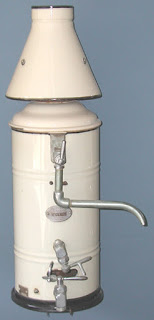My goodness. Red Nomad Oz at Amazing Australian Adventures has bestowed upon me – and nine others - The Sunshine Blog Award. I’m chuffed Red has said nice things about my blog, because she is an intelligent, witty and polished writer.
Accepting the award or even following the rules of acceptance are not mandatory. It’s a chain award of sorts, but not really a chain letter per se, as I’m not required to provide my bank account details, nor will I be looking over my shoulder if I break the chain.
One rule is that recipients of this award do not have to make long winded speeches acknowledging great-aunt Myfanwy’s match-making etc etc while ignoring wind-up signals.
Darn.
Another of the problems is a requirement that I nominate ten other blogs I think deserve the award. This is a tad difficult, because I’m rather new at blogging and don’t follow an enormous number of blogs yet. My list would have to include some what’s already got this award from someone like Red. No doubt I’d even have to award the award to someone who has no idea who I am.
How embarrassment.
Finally, it is not in my nature to impose obligations on others. As my sidebar already provides a list of blogs I like I’ve decided to complement that list today with some comments and thank yous - an obligation free award, if you will. [Nothing original here – it’s what most bloggers do anyway.]
A logical place to start is with Amazing Australian Adventures.
Red - and her partner in crime, Pilchard – travel to parts of Australia
Dina at That Weird American Who’s Obsessed With Australia was the one who inspired me to start blogging, offering lots of encouragement along the way.
Her blog has taught me heaps I never knew about Australia
If only I’d known sooner.
Dina is a self-confessed Flickr stalker, and provides links to good photos. This saves me the trouble of trawling through heaps of mediocre photos to find a good one. I probably wouldn’t bother if I had to do it myself.
Lately, this weird American woman has been providing links to quizzes about Australia
Some of the stuff Dina explores during her day is of no interest to me at all. I tend to scan this for the real gold – some thought provoking moments about life in general, all offered with real and refreshing personal honesty. It’s hard to provide an example from her 'Weird' posts which works when lifted out of context, so I offer, instead, a quote from her “unschooling” blog – a simple comment that made me question an idea I’d never questioned before:
Yes, I'm worried that something might happen to Jack...VERY worried. But it's not because I fear being childless. It's because I fear being Jackless. For those of you who feel it's better to have multiple children just in case you lose one....will the living ones really replace the child you lost? Are children that interchangeable?
Comfort Spiral.
Cloudia’s posts at Comfort Spiral are most often [though not always] a collection of stunning photographs and inspiring quotes. With music.
Visiting Comfort Spiral puts me in mind of the days when I’d go to work and turn over the next page of the desk calendar, hoping to find something witty and inspiring.
The key differences between those old desk calendars and Comfort Spiral are that Comfort Spiral is inspiring rather than disappointing; it contains colour and great pictures; and there is music.
This link will take you to the post that hooked me on Angie’s blog.
If you like people who like their kids, and if you want to read something warm written by a woman with a sense of humour, this is the place to go.
What first drew me to High Riser is Andrew ’s interest in Melbourne
Not living in the inner city, I let Andrew live there for me; whether going out to dinner, waiting for a glimpse of Her Majesty, or doing some high-quality people-watching.
As a bonus, Andrew is fascinated with machines and buildings. Looking at these particular posts has an element of past-people-watching. It would be nice to go back in time and interview people about where their inspiration came from, or what obstacles they overcame to get things done.
Every now and then Andrew says things in a way that makes me jealous of his writing; a recent gem was this:
“A black man, a red head, an Asian and a fair haired guy with dreadlocks walked into a bar together. That's all.”
Jayne, at Our Great Southern Land, has a good sense of humour, and a great nose for stories with ‘local colour’.
I tend to think of her blog as a sort of “lucky dip”; there’s always something in her posts that turns out to be a treasure for one reason or another.
Jayne sometimes gets outraged about important social issues. I like that in people.
What first drew me to Blue Skies Sunny Days was colour.
As a monochrome type person, I was bowled over by the colours of the classic paintings Rubye Jack displays on the sidebar of her blog.
Rubye Jack has also reminded me that sometimes when people talk ‘quietly’ I can’t help but listen quietly.
Windsmoke’s Fair Dinkum Haikus create fantastic images. He likes to spin a yarn every now and then, with both his yarns and riddles revealing a rare appreciation of gentle humour.
A must-read – at least until I find out if he once lived in St James St
Bizarre Scribble is a Bonza Blog.
I’m just getting to know a little about Kath Lockett who writes Blurb from the Burbs.
So far I’ve worked out that Kath – an Australian adapting to life in Geneva
This is another must-read for me – at least until I work out who the musical parent was.
Diane B at Adventure Before Dementia is another excellent photographer/writer – her travel writing is wonderful. Her recent trip to see Western Australia
It’s fortuitous that Diane likes travel, because it seems she has lived everywhere at some time or other.
A sucker for biographies, I’ve loved what I have read so far of Diane’s life story as well.
































